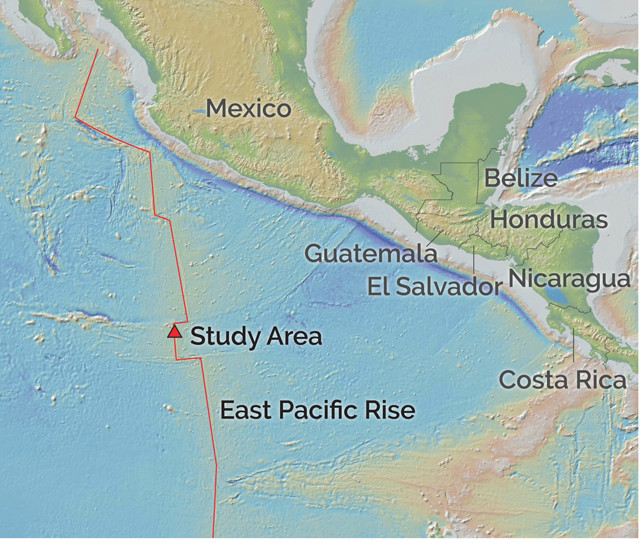
by Mary Caperton Morton Monday, March 20, 2017

The East Pacific Rise runs along the Pacific seafloor from southern California to Antarctica. Credit: K. Cantner, AGI.
In 2006, a large eruption occurred on the seafloor about 1,000 kilometers off the coast of Mexico. Geochemical dating of the erupted lava suggested the event went on for up to 10 months. Now, researchers taking a closer look at seismic and audio recordings made during the event have found that the eruption likely occurred over a much shorter period — a matter of days instead of months. The findings shed light on the sequence of events leading up to the event, as well as on the mechanisms of such seafloor eruptions.
Mid-ocean ridges are one of the most dramatic landforms on Earth, circling the globe along the seafloor. Along their length, active spreading zones pour out lava, creating new seafloor and helping drive large-scale plate tectonic movement. But tricky logistics and high costs make studying submarine volcanic eruptions a challenge, and many questions remain about how these spreading ridges operate.
“After the East Pacific Rise eruption [in 2006], there was debate about the timing of the eruption because geochemical dating suggested that the eruption happened over seven to 10 months starting in summer 2005, while the largest earthquakes happened in January 2006,” says Yen Joe Tan, a marine geophysicist at Columbia University and lead author of a new study in Nature. Even though the data analyzed in the study are nearly a decade old, Tan and his colleagues were drawn to it because “the dataset is truly unique since it’s the only well-recorded eruption on a mid-ocean ridge.”
The team reanalyzed audio and seismic data collected by ocean bottom instruments in the area and found that the sounds and shaking pointed to a rapid event, with about 85 percent of the lava erupting over two days in January 2006, and the rest spilling out within the week. They then overlapped that information with images of the freshly erupted lava on the seafloor and found that the event took place along a 35-kilometer-long segment of the ridge, producing 22 million cubic meters of new seafloor in that week, enough to cover 13 football fields in lava 300 meters deep.
The new findings inspired a reinterpretation of the events leading up to the eruption, Tan says. “We observed earthquakes before we observed any signal related to magma movement or lava erupting on the surface,” he says, “whereas at typical volcanoes, we tend to see signals related to magma movement and diking before the occurrence of the largest-magnitude earthquakes.”
The team also saw evidence for lava erupting from multiple magma sources, known as melt lenses, with variable eruption volumes and magma ascent rates, suggesting that the different melt lenses had different magma pressures. This sequence of events, Tan says, points to the main trigger for the eruption being faulting caused by building tectonic stresses, rather than building magma pressures.
The new study addresses a longstanding question, says Cynthia Ebinger, an oceanographer at the University of Rochester in New York who was not involved in the new study: “What comes first? Does faulting drive the eruption or is it driven by increasing magma pressure? This is one of the few examples where we can distinguish one trigger from the other.” Long-term study is the key to deciphering the trigger, she says. “It takes decades of paying attention to a specific place to observe and understand the sequence of events and be able to say what triggered what.”
Whether tectonic triggers are the norm along mid-ocean ridges, or whether magma pressure sometimes plays the dominant role, is still unclear. “Since this is the only seismic dataset to date that managed to record an eruption at a mid-ocean ridge in detail, we don’t really know how eruptions happen in general on ridges,” Tan says. “However, we think that this mechanism could be dominant for eruptions at mid-ocean ridges in general, but probably not for hot spot volcanism.”
Gleaning similar datasets from other seafloor settings is an important next step, Ebinger says. Real-time monitoring networks are in place on the seafloor at the Axial Seamount as well as the Endeavour Ridge Volcano, both off the Pacific Northwest coast. Continued monitoring along the East Pacific Rise may also be fruitful, Tan says, as the ridge seems to erupt on decadal timescales.
© 2008-2021. All rights reserved. Any copying, redistribution or retransmission of any of the contents of this service without the expressed written permission of the American Geosciences Institute is expressly prohibited. Click here for all copyright requests.